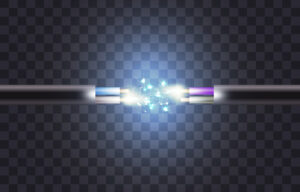
[From the last episode: We looked at different ways of accessing a single bitThe smallest unit of information. It is a shortened form of "binary digit." Since it's binary, it can have only two values -- typically 0 and 1. in a memory, including the use of multiplexors.]
Today we’re going to look more specifically at memory cells – these things we’ve been calling bit cellsA cell that stores a single bit within a memory. (Some can store more than one bit.) It connects a word line to a bit line. The bit cell can either conduct or not conduct current; those are the two states of the memory cell.. We mentioned that there are many ways of making them, and we’re going to look at a specific subset of those ways.
Traditional memories are digital: each bit cell stores a 1 or a 0. That leaves lots of margin, since anything roughly nearish a “1” will be read as a 1, and anything roughly nearish a “0” will be read as a 0. That’s the beauty of doing things digitally: you can tolerate some slop without losing information. It’s also why you can build a bit cell lots of ways: as long as you can find a way to do a 1 or 0, then you’re good.
Let’s think about this: to read a memory cell, we select a word lineA line in a memory that selects which word (and its associated bit cells) will be selected for reading or writing, based on the memory address. The word lines and bit lines are orthogonal to each other, making an array of the bit cells that connect them. – that is, bring it to a higher voltageVoltage is what gets electrons to flow. It's analogous to water pressure, which gets water to flow. Voltage is measured in units of "volts.". We then see if currentThe amount of electrical flow. Measured in amperes or amps (A). flows through the bit cell. Any path that a current flows through (within reason) will have some resistanceForces that tend to reduce the amount of flow or current. Measured in ohms (Ω).. In fact, that’s the thing that, ultimately, decides the stateA broad term that can apply to a lot of systems. Let’s say you have a system that can be one of two ways – on or off. That “on-ness” or “off-ness” is the state of the system. The system is either in an on state or an off state. Many different kinds of systems can have many different kinds of state. There are many complex branches of engineering or physics or even mathematics that deal with state. The easiest way to think of any of them is, “the way things are” (which may depend on the history of prior states, meaning how they got to this particular state). of many bit cells. If they have low resistance, then lots of current can flow. If they have high resistance, then little current can flow.
This describes a wide range of memories, most of which can store their contents even after the power goes off (so-called non-volatile memories). DRAMStands for "dynamic random access memory." This is temporary working memory in a computer. When the goes off, the memory contents are lost. It's not super fast, but it's very cheap, so there's lots of it. and SRAMStands for "static random access memory." This is also temporary memory in a computer. It's very fast compared to other kinds of memory, but it's also very expensive and burns a lot of energy, so you don't have nearly so much. don’t fit into this category, so we won’t be talking about them.
Different Physical Resistors
What kinds of memories do behave this way? We’ll talk briefly about how the cells work – they all set their resistance using different physical mechanisms. Those mechanisms also dictate how you write to the memory, but, here as before, we’re not going to talk about the writing process; just reading.
PCRAM
One of the most familiar, even if you’re not aware of it yet, is so-called phase-change RAM, or PCRAM. This takes the technology that was originally used for CDs and DVDs and adapts it to tiny cells for on-chip memory.
It uses a special kind of material (called a chalcogenide) that, depending on how you heat it, can either crystallize or stay in kind of a solid blob – an amorphous state, like glass. In the highly organized crystalline state, it can conduct current far more easily than when it’s just a chaotic blob. So in this way, you can set the cell to be more resistive (blob) or less resistive (crystal).
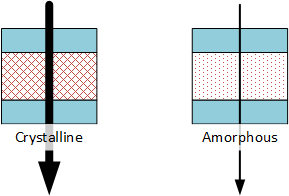
RRAM
The next type of memory is called resistive RAM, or RRAM (or ReRAM). With this bit cell, there is a way to create a conductive filament through a thin insulatorA material through which electricity cannot readily flow. Plastic is a good, familiar example.. There are different versions, with filaments made of metal or other ions. Without the filament, it’s just an insulator, so it doesn’t conduct (or it conducts very little). The filament greatly reduces the resistance, and now it can conduct.
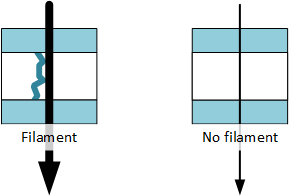
MRAM
Yet another type is called magnetic RAM, or MRAM. In this case, there are magnetic materials in the bit cell. In fact, there are two layers. One is fixed in one direction; the other one can be set either to be the same as the fixed one (parallel) or opposite to the fixed one (anti-parallel). If they’re the same, then it can conduct more current; if they’re different, then they conduct less current.
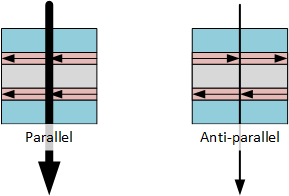
Flash
Finally, there’s flash memoryA type of memory that can retain its contents even with the power off. Thumb drives use flash memory.. People might think of this as a capacitive cell, since the thing you program affects a capacitive piece of the circuit. But, put simply, the cell stores a bunch of electronsA fundamental particle found outside atoms. It carries a negative charge. It can move easily in a conducting material, which gives rise to electrical current. in a place where they can’t escape (a so-called floating gate). They’re very close to the siliconAn element (number 14 in the periodic table) that can be a semiconductor, making it the material of preference for circuits and micro-mechanical devices., so the presence of electrons (or the lack thereof) affects how well the silicon underneath it can conduct. Those stored electrons tend to push other silicon electrons away or pull them in.
Electrons repel each other, so if there are lots of stored electrons, then they push the electrons in the silicon away from the surface*. With few (or no) stored electrons, then those surface electrons can return. Those surface electrons help establish a path, or channel, where current can flow. So, with electrons at the surface, you get lower resistance for higher current. If the stored electrons push those surface electrons away, then you have higher resistance and can’t conduct so much.
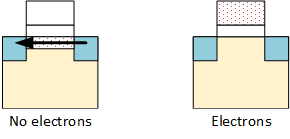
Not Just 1 or 0?
Given that these memory cells look like resistors in the end, what if we treated them not like digital memory cells, capable of only 1 or 0, but like analog cells, capable of anything between 1 and 0? We’ll take a look at what that means next week.
*Note: in theory, you can make this cell work the opposite way, but that involves another concept or two that we don’t really need to get into.

Leave a Reply